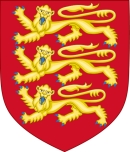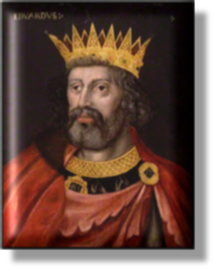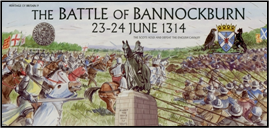


|
1307 |
Edward II becomes king and is at once faced with a serious rising in Scotland.
The Italian painter and architect Giotto di Bondone, the founder of modern painting, completes one of his major works, a series of frescoes in the Arena Chapel at Padua.
|
|
1309 |
The start of the Babylonian Captivity. Because of the political intrigues in Italy, Pope Clement V, a Frenchman, moves the papal court to Avignon in southern France.
About this time sees the emergence of the Kingdom of Benin. Situated in the southern area of modern Nigeria, in West Africa, it was to grow in strength over the next century. |
|
1311 |
The Italian painter Duccio completes one of his major works the Maestà, the altarpiece in Siena Cathedral. His work had a profound influence on the development of painting.
|
|
1312 |
The Order of Knights Templar, founded to protect pilgrims in the Holy Land during the early Crusades, is suppressed by the Avignon pope Clement V on the grounds of heresy.
|
|
1314 |
At the Battle of Bannockburn, Robert Bruce soundly defeats Edward II, expels the English from Scotland, and declares his country's independence, not officially recognised until 1328.
The Italian poet Alighieri Dante continues work on his masterpiece, The Divine Comedy. Regarded as one of the greatest epic poems of all time, it describes a journey through helI, purgatory and paradise. |
|
1318 |
Pope John XXII expands missionary work overseas, assigning Greater Armenia, Persia and India to the Dominican friars and northern Asia, including China, to the Franciscans.
|
|
1324 |
The Mali leader Mansa Musa makes a pilgrimage to Mecca and demonstrates the wealth and power of his kingdom. The Mali Empire in West Africa is now at the height of its power.
|
|
1325 |
Ibn Battuta, a Moroccan geographer, leaves Tangier on a pilgrimage to Mecca and then begins a series of travels across the world. As we shall see, he returns in 1353 (E3).
The Aztecs, an American Indian race, settle on Tenochtitlan (today's Mexico City), a marshy island which is destined to become the centre of a thriving civilisation. |
|
1326 |
The Ottomans, still on the march, capture the city of Bursa in western Anatolia. This enables them to prepare for an attack upon the Byzantine Empire across the Bosphorus.
|
|
1327 |
A parliament forces Edward to abdicate in favour of his son, Edward III. He is murdered some eight months later, probably on the orders of Roger Mortimer. |






 xxxxx
xxxxx xxxxx
xxxxx


